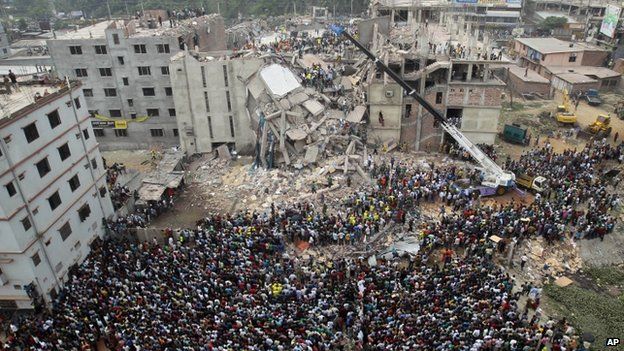4 years ago 1,134 Bangladeshis died making our clothes

One moment Reshma Begum was sewing. The next, she was falling from her station on the second floor into the basement of the Rana Plaza garment factory in Savar, Bangladesh.
She lost consciousness. She awoke to cries of help that gradually silenced. Her clothes were shredded, everything was dark, and her hair was stuck in the rubble. She ripped her hair free and scavenged the dark crevices on her hands and knees finding four crackers, a small bottle of water, and the occasional puddle to quench her thirst. She probed her surroundings with a pipe for pockets of air.
This was her life. This was her living for seventeen days.
Was Reshma’s situation an unfortunate end to an individual pursuing real opportunity in the global economy or was she exploited? Is a job in a factory better than working in the fields? Are we, as consumers, justifying the exploitation of factory and farm workers in the name of opportunity?
These aren’t easy questions to answer. In the global economy, the line between exploitation and opportunity can be pretty blurry.
A Path out of Poverty?
In his book, “The End of Poverty,” economist Jeffery Sachs calls such jobs the first rung of the global economic ladder, and he explains they’ve played an important role in Bangladesh’s development. Over the past four decades in Bangladesh per capita income has doubled, life expectancy has increased by 26 years, and the infant mortality rate has been decreased by two-thirds since 1970.
The garment industry does several things that are really important: it goes to some of the poorest places on the planet—Bangladesh has the lowest wage in the world—and it gives people, especially women, an opportunity to earn an income.
Many economists, such as Sachs, say this was the path to prosperity for Americans. We left the fields, headed to the factories, suffered poor working conditions and tragedies, but eventually wages and working standards increased, replacing the labor intense jobs with better paying, safer ones.
But not everyone is so optimistic that this trend continues today.
“A garment industry job can help keep a family from starving from hunger,” says Liana Foxvog, the director of organizing and communications for the International Labor Rights Forum, “but the vast majority of these jobs are not a path out of poverty. The fact that so many workers returned to work at Rana Plaza the day after the cracks appeared in the building is an indicator of the level of poverty these workers live in–that they would rather risk their lives than losing a month’s pay as had been threatened by some managers.”
The jobs may not be a path out of poverty, but garment workers around the world are afraid to lose the jobs all the same.
Workers in China clock out and go back to work for free because they will be replaced if they don’t. Workers in Cambodia pay bribes to get their jobs. They leave their families and the only world they’ve ever known to pursue opportunity.
When Ai, one of the eighty-five garment workers involved in sewing together a single pair of Levi’s jeans in a Cambodian factory, was told that some Americans don’t want to buy the jeans she makes because they think she should earn more than $50 per month, she quickly replied: “If people don’t buy, I’m unhappy because I wouldn’t have a job.
Is it that simple? Should we mindlessly shop and take comfort in knowing that the people who make our stuff in faraway factories have no better options?
Scott Nova of the Workers Rights Consortium estimates that to bring Bangladeshi factories up to acceptable safety standards, garments coming out of the factories would have to retail for 25-cents more.
Would you pay 25-cents more to protect Bangladeshi workers?
Leaving the farm
Ten months before Reshma was buried in the disaster that killed 1,134 fellow garment workers, she left her rural district of Dinajpur where 70% of the population farms, to pursue the opportunities of the city in Dhaka.
Many in Bangladesh and around the world are leaving the fields for the factories, hoping a job in the city sewing Levi’s or assembling iPhones will improve their lives. The United Nations projects that by 2050, 70% of the world’s population will live in cities.
From farm to factory to…?
On the seventeenth day the efforts to dig through the rubble of the Rana Plaza collapse in Bangladesh were no longer labeled as a rescue but as a recovery. Workers were looking for bodies, and they found Reshma, who outlived expectations.
Days later she recounted her experience to the international press, and ended her interview with a simple statement that shared her thoughts on her opportunity as a garment worker in the city.
“I will not work in a garment factory again.”
Americans are paying a smaller price for food and clothing than ever before; others pay much more.

Thank you for continuing to bring attention to this important human rights issue.